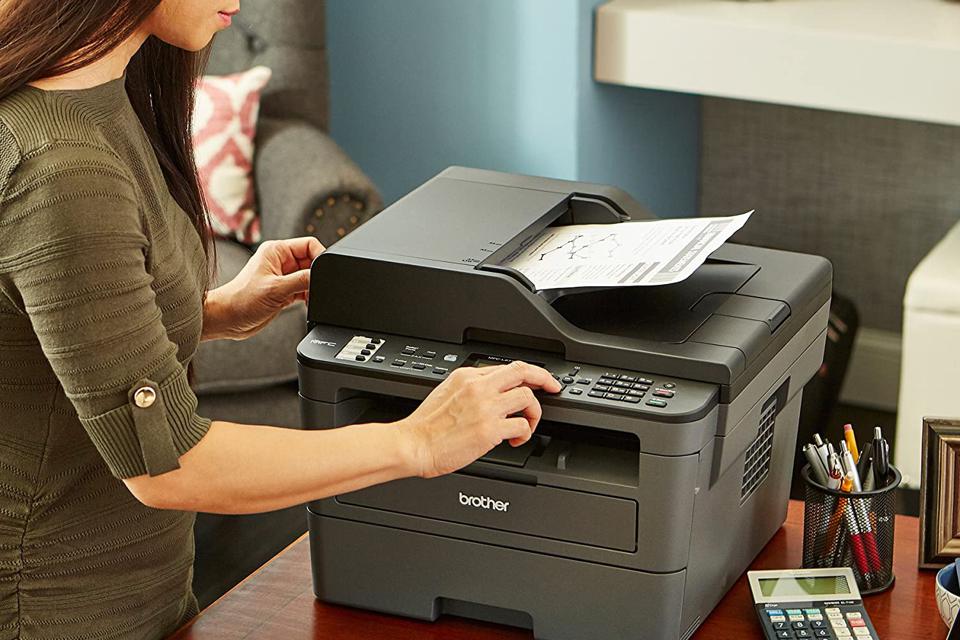A printer refers to a hardcopy peripheral device which can create human-readable representations of graphics or text on paper or other physical media. In 2019, there were 94.35 million units of hardcopy peripherals, including printers, copiers, and multifunctional systems, shipped worldwide. While printers are now mostly used in computing and information technology, recent years have seen the development of 3D printing for industrial purposes.
The main function of a photocopier is to produce paper copies of a document. Most photocopiers use laser technology, a dry process that uses electrostatic charges on a light-sensitive photoreceptor to transfer toner onto paper to form an image.
However, photocopiers and laser printers in your office or home don’t use liquid ink. They use a fine powder called toner that they melt onto the paper. Toner contains compounds that are potentially dangerous in large quantities but are safe in the quantities that you would be normally exposed to in an office. Managing your exposure to the toner and to the compounds it contains can help to maintain that safety for you and your staff.
Toxicity studies show that toners consist of low-toxicity poorly soluble particles. In experimental animals, accumulation of toner particles in the lung following long-term inhalation exposure to high toner concentrations may cause chronic inflammation and lung fibrosis. Chronic in vivo inhalation studies with rats and hamsters did not show increased lung tumor rates. However, intratracheal instillation of very high toner doses produced significantly increased lung tumor rates in rats. Since there is no significant exposure of consumers to toners using copiers and laser printers these effects are unlikely to occur in humans. Case reports show that inhalation exposure to toner may be associated with symptoms of the upper and lower airways in sensitive subjects.
In addition, a new study by West Virginia University researcher Nancy Lan Guo, the microscopic toner nanoparticles that waft from laser printers may change our genetic and metabolic profiles in ways that make disease more likely. Her findings appear in the International Journal of Molecular Sciences.
“The changes are very significant from day one,” said Guo, a professor in the School of Public Health and member of the Cancer Institute.
How The Ingredients In Photocopiers and Printer Toner Could Affect you
Carbon Black: the primary ingredient in most black photocopier and laser printer toners is carbon black, although some cartridges use an oxide of iron instead. Chemically related to coal and pencil lead, carbon black is a pigment. In a 1996 study conducted by the International Agency for Research on Cancer, the method of manufacturing was linked to genetic mutations in bacteria. However, the manufacturing process has since changed, and no studies have linked it to cancer, noted the Health and Safety Department of the University of Edinburgh in 2010.
Carbon black may contain impurities known to be carcinogens.
Contact with the tongue can lead to:
- small growths
- irritated eyes
- headache
- itching skin
Direct contact with toner can lead to skin and eye sensitization
Polymers and Resins: toners also contain resins or polymers that bond to the pigment particles. When the copier heats the page on its way out of the printer, the resins or polymers melt, locking the pigment on the page. Some of these polymers are made of volatile chemicals that in large quantities could be dangerous to inhale. This problem is especially acute if you are close to the copier when it is operating since it heats and potentially vaporizes some of the toner.
Other Chemicals: some toners are made with naphtha, a petrochemical related to gasoline, while others include styrene acrylate. In a properly functioning copier or printer, these compounds are sealed inside the toner cartridge or securely melted onto the paper. As such, they should not pose a real health hazard.
Chemicals generated during the operation of a typical photocopier include ozone, carbon monoxide, nitrogen oxide, and volatile organic compounds.
Ozone is produced during the high voltage electrical discharge in photocopiers. It is highly toxic, with health effects such as:
- eye, nose, throat, and lung irritation
- dermatitis
- headaches
- nausea
- premature aging
- potential reproductive dangers
How to Prevent Printer and Photocopier related Risks and Diseases
Normal day-to-day photocopying appears to be harmless, according to the Health and Safety Department of the University of Edinburgh. However, the health hazards of the resins, polymers, and other chemicals in toner could come into play if you inhale large quantities of those chemicals.
Breathing in hazardous substances at work can put your employees’ health at risk and may cause a range of respiratory diseases and conditions from asthma, chronic obstructive pulmonary disease (COPD), and cancers. It can also cause other diseases of the airways and lungs, for example, airway obstruction, bronchitis, or lung cancers. As well as this, it can cause cancer in other parts of the body, nervous system diseases, and disorders of reproductive organs.
The key to preventing the health hazards of toner in printers, photocopiers, and associated devices is to avoid inhaling it as much as possible. If you work in close proximity to a busy copy machine or printer, make sure that your workspace is well-ventilated, and if you are responsible for cleaning toner spills or the inside of copiers, consider wearing a face mask to protect you from inhaling toner. Consider getting an N95 face mask if you want the best dust protection you can get while working close to these machines. An N95 respirator mask is a respiratory protective device with high filtration efficiency to airborne particles. ALSO SEE: How To Use Personal Protective Equipment (PPE)






